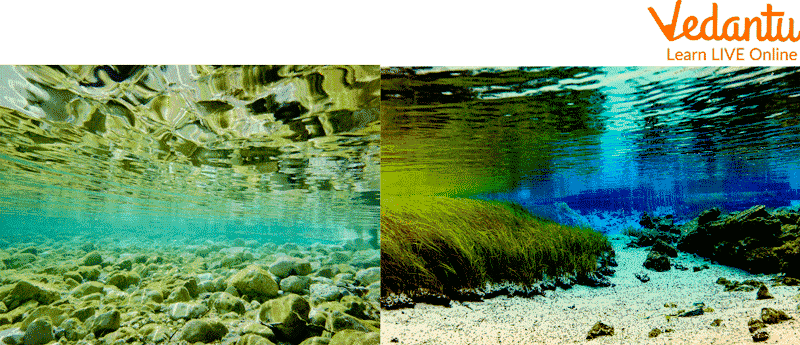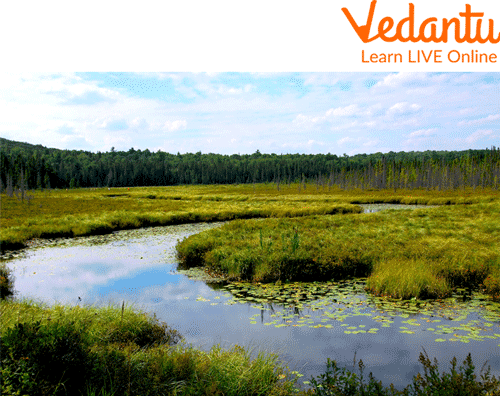




What Makes the Freshwater Biome Unique?
Have you ever thought about what percentage of the earth's surface is covered with freshwater? Our earth's surface is covered with about 71 percent water, out of which only 3 percent is freshwater. Freshwater is defined as any natural liquid with a minor content of salt and impurities present. It is available in the form of ice, glacier or groundwater. Out of the total 3 per cent available freshwater, only 1.2 percent can be used for drinking purposes. This article covers facts about freshwater biomes and freshwater ecosystems, along with their characteristics and types.
What is a Freshwater Biome?
A broad group of flora and fauna i.e. plants and animals which inhabit water bodies with a salt content typically less than 1% is referred to as a freshwater biome. Lakes, ponds, streams, rivers, and even certain wetlands are some examples of freshwater biomes. These are far different from the marine biome.

Freshwater Biome
Facts About the Freshwater Biome
Some interesting facts about the freshwater biome are given below:
Only 3 % of the available water on the surface of the earth originates from freshwater biomes.
99 % of freshwater is in the form of ice or situated in aquifers.
The freshwater biome is a hub for a variety of animals, out of which mostly are fish, covering about 700 different species.
These serve as the residence for over 1 lakh plants and animals.
It contains approximately 41 % of the total fish in the world.
What is a Freshwater Ecosystem?
A freshwater ecosystem has low levels of salinity, providing a favourable settling for a variety of plants and animals. There occur different sizes of freshwater resources ranging from very small to very large.
Types of Freshwater
There are three types of freshwater ecosystems namely:
Running Water Ecosystem
A running water ecosystem is a collection of flowing water bodies. These include rivers and streams. Running water ecosystems are also called lotic water ecosystems. These environments harbour various species of insects. Some of the commonly found insects include beetles, mayflies, stoneflies and several species of fish including trout, eel, minnow, etc. Examples of running water ecosystem include waterfall, river, ponds etc

Running Water Ecosystems
Standing Water Ecosystem
A standing water ecosystem is a type of aquatic ecosystem which is found in still or stagnant bodies of water, such as lakes and ponds. A standing water ecosystem is also called a lentic or lacustrine water ecosystem. These ecosystems are habited by algae, crabs, shrimps, amphibians, frogs and salamanders.

Standing Water Ecosystem
Wetland Water Ecosystem
The Wetland water ecosystem contain water which is still and is home to several vascular plants. Wetland water ecosystems are highly productive. Many plants live in this type of ecosystem. Some varieties of plants in this ecosystem include marshes and swamps, bogs, and water lilies.

Wetland Ecosystem
Characteristics of Freshwater Ecosystem
Freshwater ecosystem characteristics are given below:
Numerous plant and animal species can be found in the freshwater ecosystem.
A freshwater ecosystem contains a lot of nutrients and minerals.
Freshwater ecosystems are less salinized when compared to other marine ecosystems.
The freshwater habitat experiences a temperature between 30 to 71 degrees Fahrenheit during summers, while in winters, it fluctuates between 35 and 45 degrees Fahrenheit.
Freshwater ecosystems vary in size and shape depending on their location, the area covered, and the depth of the water bodies.
Sediments are present at the bottom of the freshwater ecosystem, which does not move in standing or gently flowing bodies of freshwater.
Summary
In this article, we have covered the freshwater biomes, various facts about freshwater biomes, types of freshwater, and freshwater ecosystem characteristics. It uses images to make learning simple and interesting. This information is useful for the students in safeguarding their future. By reading this, they would have a clear picture in their mind of why they should save water. Hoping this article would be beneficial for you in learning the concepts deeply. Feel free to ask your doubts in the comments.
FAQs on Must-Know Facts About the Freshwater Biome
1. What are some key facts about the freshwater biome?
The freshwater biome, despite covering less than 1% of the Earth's surface, is incredibly important. Here are some key facts about it:
- Low Salt Content: Its defining characteristic is a very low salt concentration, typically less than 1%. This is known as low salinity.
- Houses Diverse Life: It is home to more than 100,000 aquatic species, including numerous fish, amphibians, insects, and plants.
- Three Main Types: Freshwater biomes are generally categorised into three types: lakes and ponds (still water), rivers and streams (flowing water), and wetlands (areas where soil is saturated with water).
- Essential for Humans: These biomes provide most of the drinking water for humans and animals, and are crucial for agriculture and industry.
2. What are the three main types of freshwater biomes?
Freshwater biomes are classified into three primary categories based on the movement and characteristics of the water:
- Lakes and Ponds: These are bodies of still or standing freshwater, known as lentic ecosystems. They vary greatly in size and depth, and often have distinct zones of life based on sunlight penetration.
- Rivers and Streams: These are bodies of flowing water, known as lotic ecosystems. The constant movement of water creates a unique environment where organisms are adapted to currents.
- Wetlands: These are areas where the soil is saturated or flooded with water for at least part of the year. Examples include swamps, marshes, and bogs. Wetlands act as natural filters, purifying water and preventing floods.
3. What is the importance of freshwater biomes?
Freshwater biomes are critically important for both ecological balance and human survival. Their importance includes:
- Source of Drinking Water: They are the primary source of clean drinking water for countless species, including humans.
- Support for Biodiversity: They provide essential habitats for a vast range of aquatic and terrestrial organisms, supporting complex food webs.
- Agricultural and Industrial Use: Water from these biomes is essential for irrigating crops and for various industrial processes.
- Nutrient Cycling: They play a key role in the Earth's natural cycles, including the water cycle and the recycling of essential nutrients.
4. What kind of animals and plants live in a freshwater biome?
The freshwater biome hosts a rich variety of life adapted to its unique conditions. Common inhabitants include:
- Animals: A wide range of fish like trout, bass, and catfish; amphibians such as frogs and salamanders; reptiles like turtles and snakes; and many invertebrates including snails, crayfish, and insects like dragonflies. Mammals like otters and beavers are also common.
- Plants: Plant life includes algae and phytoplankton which form the base of the food web. Larger plants like cattails, water lilies, and reeds grow along the banks (littoral zone), while submerged plants like duckweed are also found.
5. What are the main characteristics of a freshwater biome?
The defining characteristics of a freshwater biome are determined by several physical and chemical factors. The most important ones are low salinity (less than 1% salt), temperature, light penetration, and water movement. The climate can vary significantly depending on the biome's geographical location, from tropical to polar regions. The chemistry of the water, including its pH level and oxygen content, also plays a crucial role in shaping the habitat and determining which species can thrive there.
6. How does the movement of water create different types of freshwater habitats?
The movement of water is a primary factor that divides freshwater biomes into two main habitat types: lentic and lotic systems.
- Lentic systems refer to still or slow-moving water, like in ponds and lakes. In these habitats, organisms like phytoplankton can flourish, and life is often zoned by depth and light.
- Lotic systems refer to rapidly moving water, as found in rivers and streams. Here, organisms must be adapted to survive strong currents. For example, fish may have streamlined bodies, and insects may have hooks to cling to rocks. The constant flow also keeps the water well-oxygenated.
7. Why is low salt concentration the most critical feature of a freshwater biome?
Low salt concentration, or salinity, is the most critical feature because it dictates the biological processes of every organism living there. All life in a freshwater biome is adapted to a hypotonic environment, meaning the concentration of salt inside their bodies is higher than in the surrounding water. They have developed special biological systems for osmoregulation to prevent their cells from absorbing too much water and bursting. This is the fundamental difference that separates freshwater life from marine life, which is adapted to a high-salt (hypertonic) environment.
8. How do factors like sunlight and depth affect life in freshwater biomes like lakes?
Sunlight and depth create distinct vertical zones within freshwater biomes, especially in lakes and deep ponds. These zones support different types of life:
- Photic Zone: This is the upper layer of water where sunlight can penetrate, allowing photosynthesis to occur. It is rich in oxygen and supports photosynthetic organisms like algae and phytoplankton, as well as the animals that feed on them.
- Aphotic Zone: This is the deeper, darker layer of water where little to no sunlight reaches. Photosynthesis is not possible here. Life in this zone consists of decomposers and scavengers that feed on dead organic matter sinking from above.
This layering, known as thermal stratification, significantly influences where different species can live and find food.









